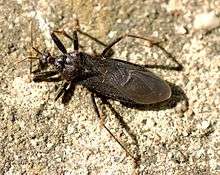Reduvius personatus
Reduvius personatus or the masked hunter is an insect belonging to the assassin bug (Reduviidae) family. The name is because its nymphs camouflage themselves with dust. The masked hunter is a predator of small arthropods, including woodlice, lacewings, earwigs, bed bugs and termites.[1] Masked hunters do not feed on human blood, but can bite humans in self-defense when mishandled.[2] The bite can be extremely painful, but masked hunters are not known to transmit any diseases and medical attention is rarely needed.[3]
| Reduvius personatus | |
|---|---|
 | |
| Scientific classification | |
| Kingdom: | Animalia |
| Phylum: | Arthropoda |
| Class: | Insecta |
| Order: | Hemiptera |
| Family: | Reduviidae |
| Genus: | Reduvius |
| Species: | R. personatus |
| Binomial name | |
| Reduvius personatus | |
Identification
Adult masked hunters are uniformly dark brown to black in color and vary in length from 17–22 mm.[4] They have an elongated head that includes a short, three-segmented beak, as well as long, slender antennae.[5] Their abdomen is wide, extending in the middle beyond the wings to reveal the lateral margins of their abdominal segments.[6] Nymphs of this species resemble the adult form and are naturally dark-colored, but often appear grey or light-colored due to a camouflage layer of debris covering them.[7] Nymphs exude a sticky substance that covers their entire body, including the antennae and all six legs, which causes dust, lint, and other small particles to adhere to the surface of their body.[8]
Natural history
Distribution
The masked hunter has a Holarctic distribution.[9] It is native to Europe, but was accidentally transported to North America and is now common in the Central and Eastern United States. It can be also found in South Africa and Eastern Canada. It has also been found in high desert regions of the North West United States. [10]
Lifecycle
Masked hunters, like other Hemiptera, undergo incomplete metamorphosis. Early stages of the lifecycle look like small adults and are called nymphs. Normally, one generation of masked hunter bugs occurs per year. Adults are common during midsummer, but can also be found in the winter.[11]
Behavior
_nymph%2C_Middle_Franconia%2C_Germany_-_20110820-04.jpg)
Nymphs of R. personatus use their hind legs and a tarsal fan to construct a camouflaging layer of substrate on their bodies.[12] Two layers are formed, an inner layer of fine particles and an outer layer of coarser particles. The formation of these two layers may be the reason for the presence of long and short trichomes on the nymphs. Nymphs may use the serrated setae present on their abdomens to assist in loosening substrate for use in camouflage. The camouflage may assist the nymph in avoiding detection by both predators and prey. They hunt bed bugs at night, as well as other prey.
Both the nymphs and adults are predatory, feeding on various arthropods by piercing their bodies with sucking mouthparts.[13]
Masked hunters prefer dry habitats and are usually only found in small numbers when they infest houses.
Human impact
Masked hunters deliver a bite comparable to a bee's sting when handled or trapped. The bite can cause swelling that lasts for about a week.[14] Because they feed on a wide variety of arthropods, they sometimes are found in homes with bed bug infestations. They can generally be controlled by dealing with the bed bug infestation.
References
- "Iowa State University BugGuide". Retrieved 2009-02-22.
- "Getting Personal with Personatus". Retrieved 2016-07-05.
- "University of Minnesota Yard and Garden Briefs - Masked hunters". Retrieved 2016-07-05.
- "Pest Diagnostic Clinic, Factsheet on Assassin Bugs". Retrieved 2009-01-30.
- "Assassin Bugs, HYG-2082-98". Retrieved 2009-08-02.
- "A Literature-based Key to REDUVIIDAE (Heteroptera) of Florida" (PDF). Retrieved 2009-08-02.
- "Masked Hunters". Retrieved 2009-08-02.
- "Assassin Bugs, HYG-2082-98". Retrieved 2009-08-02.
- "Iowa State University BugGuide". Retrieved 2009-02-22.
- "University of Minnesota Yard and Garden Briefs". Archived from the original on 2010-03-23. Retrieved 2009-02-22.
- "Wisconsin Horticulture". UW Extension Cooperative Extension. Retrieved 2012-12-26.
- Wierauch C. 2006. Anatomy of Disguise: Camouflaging Structures in Nymphs of Some Reduviidae (Heteroptera). Am. Mus. Novit. 3542: 1-18
- "Michigan State University Diagnostic Services". Retrieved 2009-02-22.
- "Masked Hunters". Retrieved 2009-02-22.
External links
| Wikimedia Commons has media related to Reduvius personatus. |